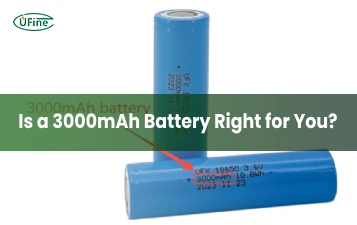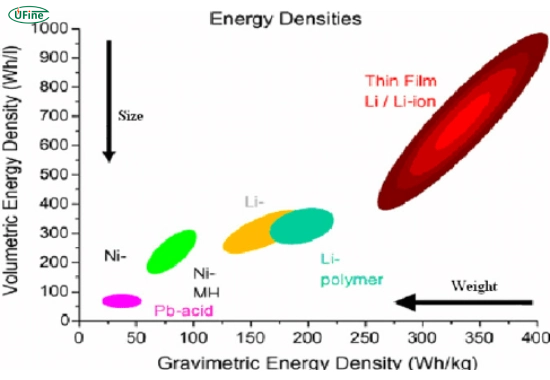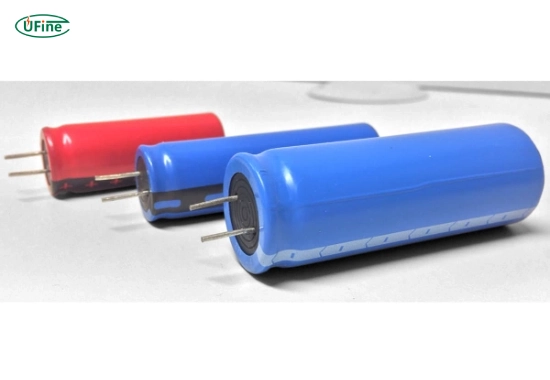Lithium-ion batteries have revolutionized portable electronics and electric vehicles, offering a lightweight, energy-dense solution for powering modern lives. High-density lithium-ion batteries stand out as an emerging development area in lithium-ion technology. But what makes a high-density lithium-ion battery superior? This article explores the key characteristics, advantages, and applications of these advanced batteries, highlighting their potential to transform industries.
Part 1. Understanding lithium-ion battery density
What is energy density, and why is it important? Energy density refers to how much energy a battery can store compared to its size or weight. A high-density lithium-ion battery stores more energy in a smaller or lighter form than a regular lithium-ion battery. This directly affects how long a device runs before recharging and how heavy or bulky the battery is.
There are two main types of energy density:
- Volumetric Energy Density: The energy stored per unit volume (Wh/L).
- Gravimetric Energy Density: The energy stored per unit mass (Wh/kg).
Both types are important, but their significance can vary depending on the application. For instance, volumetric energy density is more critical in smartphones with limited space. In electric vehicles, gravimetric energy density is vital to reduce weight and improve range.
Part 2. The science behind high-density lithium-ion batteries
How do scientists improve energy density in lithium-ion batteries? Increasing energy density involves enhancing key components: the cathode, anode, electrolyte, and separator.
Advanced Cathode Materials: The cathode is often the limiting factor in a battery’s energy density. Researchers are exploring materials with higher lithium storage and higher operating voltages. Some promising materials include:
- Nickel-rich NMC (Nickel Manganese Cobalt) oxides: More nickel in NMC cathodes increases energy density.
- Lithium-rich NMC oxides: These materials can store even more lithium ions, boosting energy density.
- High-voltage cathodes: Materials that work at higher voltages can increase energy density.
Improved Anode Materials: The anode also plays a key role. Graphite is commonly used, but alternatives like:
- Silicon: Silicon stores more lithium but expands and contracts during charging, causing degradation. Researchers are working on nanostructured silicon to address this.
- Lithium Metal: Lithium metal anodes offer the highest capacity but have safety risks due to dendrite formation. Solid-state electrolytes are being developed to address these issues.
Optimized Electrolytes: Electrolytes allow lithium ions to move between the cathode and anode. New electrolytes can improve performance and stability.
- Additives: Additives can improve stability and prevent electrolyte breakdown.
- Solid-State Electrolytes: These replace liquid electrolytes with solid materials, enabling safer lithium metal anodes.
Innovative Separators: Separators prevent the cathode and anode from touching while allowing lithium ions to pass through. Better separators can improve both safety and performance.
- High-Temperature Separators: These can withstand higher temperatures, improving safety.
- Coatings: Separator coatings improve ionic conductivity and wettability.
Part 3. Advantages of high-density lithium-ion batteries
What benefits do high-density lithium-ion batteries offer over regular ones? These batteries provide several advantages:
- Extended Range and Runtime: Storing more energy in the same size and weight leads to longer device runtimes and extended ranges for electric vehicles.
- Reduced Weight and Size: High-density batteries allow for smaller, lighter devices without sacrificing performance, which is crucial in drones, wearables, and aerospace.
- Improved Performance: High-density batteries often provide higher power output, boosting performance in electric vehicles and power tools.
- Cost Savings: Although high-density batteries may cost more upfront, they offer savings over time due to fewer charging cycles and longer lifespans.
Part 4. Applications of high-density lithium-ion batteries
Where are high-density lithium-ion batteries used today, and where will they be used in the future? Their superior features make them ideal for many applications:
- Electric Vehicles (EVs): High-density batteries enable EVs to travel longer on a single charge, making them more practical and efficient.
- Portable Electronics: High-density batteries benefit devices like smartphones, laptops, and tablets by providing longer battery life and better performance.
- Aerospace: High-density batteries provide a lightweight, energy-dense power source for drones, electric aircraft, and satellites.
- Medical Devices: Portable medical devices like ventilators and wearable health monitors rely on high-density batteries for long-lasting, reliable power.
- Energy Storage Systems (ESS): Grid-scale storage systems use high-density batteries to store excess energy from renewable sources like solar and wind.
Part 5. Challenges and future directions with high-density lithium-ion batteries
What challenges do high-density lithium-ion batteries face, and how are researchers addressing them? Despite their benefits, there are still some issues:
- Safety: Some materials, like lithium metal anodes, are reactive and pose safety risks. Researchers are developing safer electrolytes and cell designs to reduce these risks.
- Stability: Materials like silicon anodes expand and contract, leading to capacity loss over time. Improved materials and designs are needed for better stability.
- Cost: High-density batteries are more expensive due to advanced materials and manufacturing processes. However, costs are expected to decrease as production scales up.
- Manufacturing: Producing high-density batteries is more complex than conventional ones. Innovation in manufacturing techniques is necessary to improve scalability and cost-effectiveness.
Ongoing research focuses on overcoming these challenges. Some promising areas include:
- Solid-State Batteries: Solid-state batteries replace liquid electrolytes with solids, improving safety, energy density, and lifespan.
- Lithium-Sulfur Batteries: Lithium-sulfur batteries promise even higher energy densities, but face issues like sulfur dissolution.
- Advanced Manufacturing Techniques: New methods, such as 3D printing and roll-to-roll processing, could reduce costs and improve production efficiency.
Part 6. The role of electrolytes in density
How do electrolytes affect lithium-ion battery energy density? Electrolytes are essential for lithium ions to move between the cathode and anode. The properties of the electrolyte influence the battery’s performance and energy density.
- Ionic Conductivity: High ionic conductivity is necessary for efficient lithium-ion transport. Low conductivity can limit power and energy density.
- Electrochemical Stability: The electrolyte must remain stable over a wide voltage range to avoid decomposition and side reactions that reduce battery life.
- Compatibility with Electrode Materials: The electrolyte must work well with the cathode and anode to prevent corrosion and ensure stable interfaces.
- Additives: Additives improve performance by stabilizing the electrode-electrolyte interface and enhancing conductivity.
Part 7. The future of solid-state electrolytes
Why are solid-state electrolytes considered game-changing for high-density lithium-ion batteries? Solid-state electrolytes replace liquid electrolytes with a solid material, offering several advantages:
- Enhanced Safety: Solid-state electrolytes are non-flammable and non-volatile, reducing risks like leakage and thermal runaway.
- Higher Energy Density: They allow the use of lithium metal anodes, which can significantly increase energy density.
- Improved Stability: Solid-state electrolytes provide a more stable interface, reducing side reactions and enhancing battery life.
- Wider Operating Temperature Range: Some solid-state electrolytes function over a broader temperature range, ideal for extreme environments.
Part 8. How silicon anodes are changing the game?
What makes silicon anodes so promising for higher energy density in lithium-ion batteries? Silicon is a promising anode material due to its high theoretical capacity—about ten times greater than graphite—allowing for more lithium storage and higher energy densities.
- High Theoretical Capacity: Silicon’s high capacity could significantly improve energy density.
- Abundance: Silicon is abundant and inexpensive, making it a cost-effective alternative to other materials.
However, silicon anodes face challenges:
- Volume Expansion: Silicon expands and contracts during charging, causing cracking and capacity loss.
- Poor Conductivity: Silicon has low electrical conductivity, limiting power output.
Researchers are exploring solutions like:
- Nanostructured Silicon: Nanowires and nanoparticles can help manage volume changes and improve conductivity.
- Silicon Composites: Combining silicon with carbon can improve its strength and conductivity.
Artikel Terkait: What You Need to Know About Silicon Battery Anodes in Lithium-Ion Batteries
Part 9. The Impact of high-voltage cathodes
How do high-voltage cathodes improve energy density? A lithium-ion battery’s energy density increases with the cathode material’s operating voltage. High-voltage cathodes store more energy for the same amount of material.
- Higher Energy Density: High-voltage cathodes increase the energy stored in a battery.
- Improved Performance: High-voltage cathodes can enhance power output and efficiency.
Challenges include:
- Electrolyte Decomposition: High-voltage cathodes can cause electrolyte breakdown, reducing capacity and lifespan.
- Material Instability: Some high-voltage materials are unstable, limiting performance.
Researchers are working on new materials and additives to improve the stability and performance of high-voltage batteries.
Part 10. The economics of high-density batteries
Are high-density lithium-ion batteries worth the investment? Though they often cost more upfront, their efficiency and lifespan can provide long-term value.
- Longer Lifespan: High-density batteries last longer, reducing replacement costs.
- Reduced Charging Frequency: Longer runtime means fewer charging cycles, saving on electricity costs.
- Increased Efficiency: High-density batteries are more efficient and waste less energy.
- Resale Value: Products powered by high-density batteries, like EVs, may have higher resale values.
- Reduced Downtime: Longer battery life reduces downtime in industrial settings, boosting productivity.
Part 11. FAQs
-
What is the main difference between a regular lithium-ion battery and a high-density one?
A high-density lithium-ion battery stores more energy for the same size and weight, leading to longer runtimes and improved performance compared to a regular lithium-ion battery. -
Are high-density lithium-ion batteries safe to use?
Yes, but safety depends on the materials used and the battery design. Solid-state electrolytes are being developed to enhance safety further. -
How do high-density batteries impact the range of electric vehicles?
High-density batteries allow electric vehicles to travel longer distances on a single charge, significantly reducing users’ range anxiety. -
What are the key applications of high-density lithium-ion batteries?
They are widely used in electric vehicles, portable electronics, aerospace, medical devices, and energy storage systems, providing improved performance and longer runtimes. -
What is the future outlook for high-density lithium-ion battery technology?
The future is promising, with ongoing research into solid-state batteries, lithium-sulfur batteries, and advanced manufacturing techniques that aim to improve battery performance, safety, and cost reduction.
Related Tags:
More Articles

Is a 3000 mAh Lithium Battery Enough for Your Device?
Wondering what a 3000mAh battery means? Learn about its power, lifespan, types, and how to choose the best one for your device!
Learn About Lithium Battery Kits
Discover the ultimate guide to lithium battery kits—types, safety, installation, and cost analysis. Make the right choice for solar, RV, or off-grid power!
Selecting the Perfect Ah for Your 48V Li-ion Battery Pack
Struggling to choose the right Ah for your 48V Li-ion battery pack? This in-depth guide covers everything you need to make the best choice. Find out more now!
LiFePO4 Pouch Cells Explained: Advantages, Applications & Comparison
Learn all about LiFePO4 pouch cells, their structure, lifespan, advantages, and how they outperform other lithium battery types. Make the right choice!
12Ah Lithium Battery Guide: Uses, Lifespan & Tips
12Ah lithium batteries last longer, charge faster & weigh less than lead-acid. See best uses, charging tips & how to extend lifespan!






